University of Canberra: Social Influence and Brand Marketing Essay
VerifiedAdded on 2022/12/26
|9
|3059
|69
Essay
AI Summary
This essay delves into the crucial role of social influence and persuasion in shaping consumer behavior within the context of brand marketing. It explores various facets of social influence, ranging from the mere presence effect to the impact of online reviews and advergames, and how organizations leverage these elements to create brand awareness and influence purchasing decisions. The discussion covers the interplay between consumer attitudes, resistance to persuasion, and the effectiveness of different marketing strategies, including brand integration and social marketing. The essay also examines the impact of social influencers, online reviews, and the use of advergames as tools for brand marketing, highlighting their advantages and challenges. Furthermore, it explores the influence of social psychology, normative and informational influence, and the impact of celebrity endorsements on consumer behavior. Ultimately, the essay provides insights into how companies utilize multidisciplinary consumption triggers and communication techniques to effectively persuade consumers and drive behavioral changes in brand marketing.
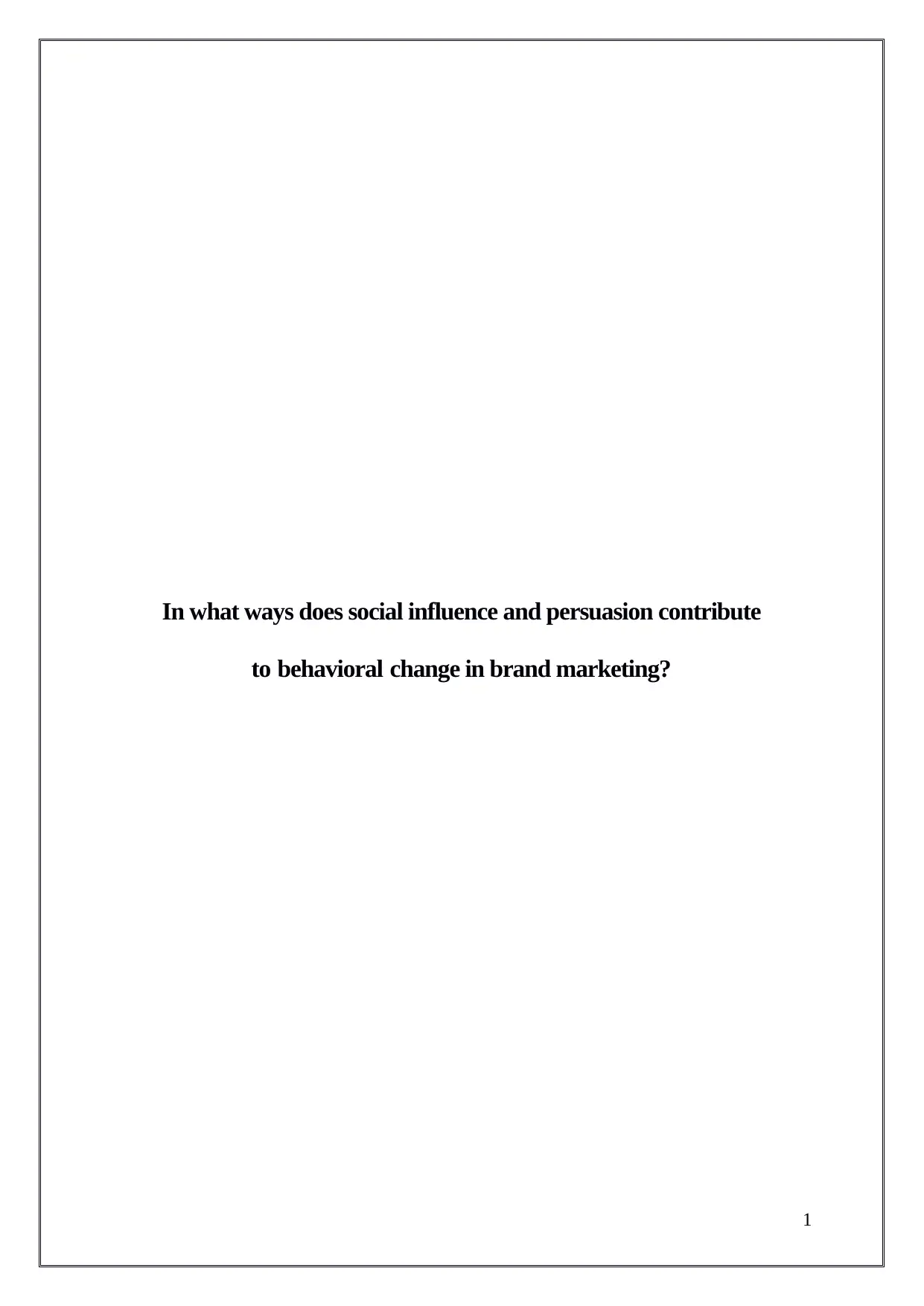
In what ways does social influence and persuasion contribute
to behavioral change in brand marketing?
1
to behavioral change in brand marketing?
1
Paraphrase This Document
Need a fresh take? Get an instant paraphrase of this document with our AI Paraphraser

Table of Contents
1. Introduction............................................................................................................................3
2. Discussion..............................................................................................................................3
3. Conclusion..............................................................................................................................7
Reference list..............................................................................................................................8
2
1. Introduction............................................................................................................................3
2. Discussion..............................................................................................................................3
3. Conclusion..............................................................................................................................7
Reference list..............................................................................................................................8
2
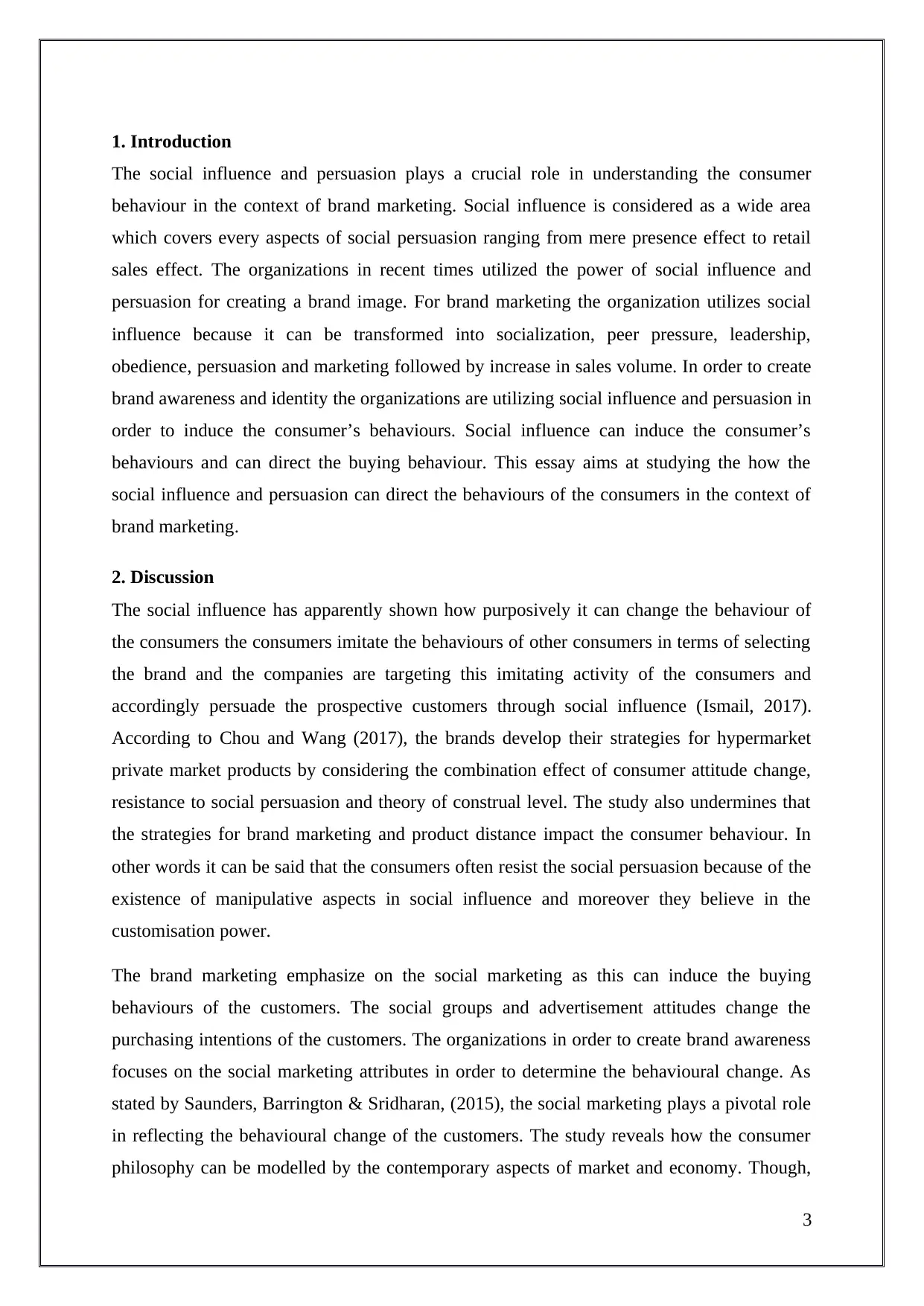
1. Introduction
The social influence and persuasion plays a crucial role in understanding the consumer
behaviour in the context of brand marketing. Social influence is considered as a wide area
which covers every aspects of social persuasion ranging from mere presence effect to retail
sales effect. The organizations in recent times utilized the power of social influence and
persuasion for creating a brand image. For brand marketing the organization utilizes social
influence because it can be transformed into socialization, peer pressure, leadership,
obedience, persuasion and marketing followed by increase in sales volume. In order to create
brand awareness and identity the organizations are utilizing social influence and persuasion in
order to induce the consumer’s behaviours. Social influence can induce the consumer’s
behaviours and can direct the buying behaviour. This essay aims at studying the how the
social influence and persuasion can direct the behaviours of the consumers in the context of
brand marketing.
2. Discussion
The social influence has apparently shown how purposively it can change the behaviour of
the consumers the consumers imitate the behaviours of other consumers in terms of selecting
the brand and the companies are targeting this imitating activity of the consumers and
accordingly persuade the prospective customers through social influence (Ismail, 2017).
According to Chou and Wang (2017), the brands develop their strategies for hypermarket
private market products by considering the combination effect of consumer attitude change,
resistance to social persuasion and theory of construal level. The study also undermines that
the strategies for brand marketing and product distance impact the consumer behaviour. In
other words it can be said that the consumers often resist the social persuasion because of the
existence of manipulative aspects in social influence and moreover they believe in the
customisation power.
The brand marketing emphasize on the social marketing as this can induce the buying
behaviours of the customers. The social groups and advertisement attitudes change the
purchasing intentions of the customers. The organizations in order to create brand awareness
focuses on the social marketing attributes in order to determine the behavioural change. As
stated by Saunders, Barrington & Sridharan, (2015), the social marketing plays a pivotal role
in reflecting the behavioural change of the customers. The study reveals how the consumer
philosophy can be modelled by the contemporary aspects of market and economy. Though,
3
The social influence and persuasion plays a crucial role in understanding the consumer
behaviour in the context of brand marketing. Social influence is considered as a wide area
which covers every aspects of social persuasion ranging from mere presence effect to retail
sales effect. The organizations in recent times utilized the power of social influence and
persuasion for creating a brand image. For brand marketing the organization utilizes social
influence because it can be transformed into socialization, peer pressure, leadership,
obedience, persuasion and marketing followed by increase in sales volume. In order to create
brand awareness and identity the organizations are utilizing social influence and persuasion in
order to induce the consumer’s behaviours. Social influence can induce the consumer’s
behaviours and can direct the buying behaviour. This essay aims at studying the how the
social influence and persuasion can direct the behaviours of the consumers in the context of
brand marketing.
2. Discussion
The social influence has apparently shown how purposively it can change the behaviour of
the consumers the consumers imitate the behaviours of other consumers in terms of selecting
the brand and the companies are targeting this imitating activity of the consumers and
accordingly persuade the prospective customers through social influence (Ismail, 2017).
According to Chou and Wang (2017), the brands develop their strategies for hypermarket
private market products by considering the combination effect of consumer attitude change,
resistance to social persuasion and theory of construal level. The study also undermines that
the strategies for brand marketing and product distance impact the consumer behaviour. In
other words it can be said that the consumers often resist the social persuasion because of the
existence of manipulative aspects in social influence and moreover they believe in the
customisation power.
The brand marketing emphasize on the social marketing as this can induce the buying
behaviours of the customers. The social groups and advertisement attitudes change the
purchasing intentions of the customers. The organizations in order to create brand awareness
focuses on the social marketing attributes in order to determine the behavioural change. As
stated by Saunders, Barrington & Sridharan, (2015), the social marketing plays a pivotal role
in reflecting the behavioural change of the customers. The study reveals how the consumer
philosophy can be modelled by the contemporary aspects of market and economy. Though,
3
⊘ This is a preview!⊘
Do you want full access?
Subscribe today to unlock all pages.

Trusted by 1+ million students worldwide
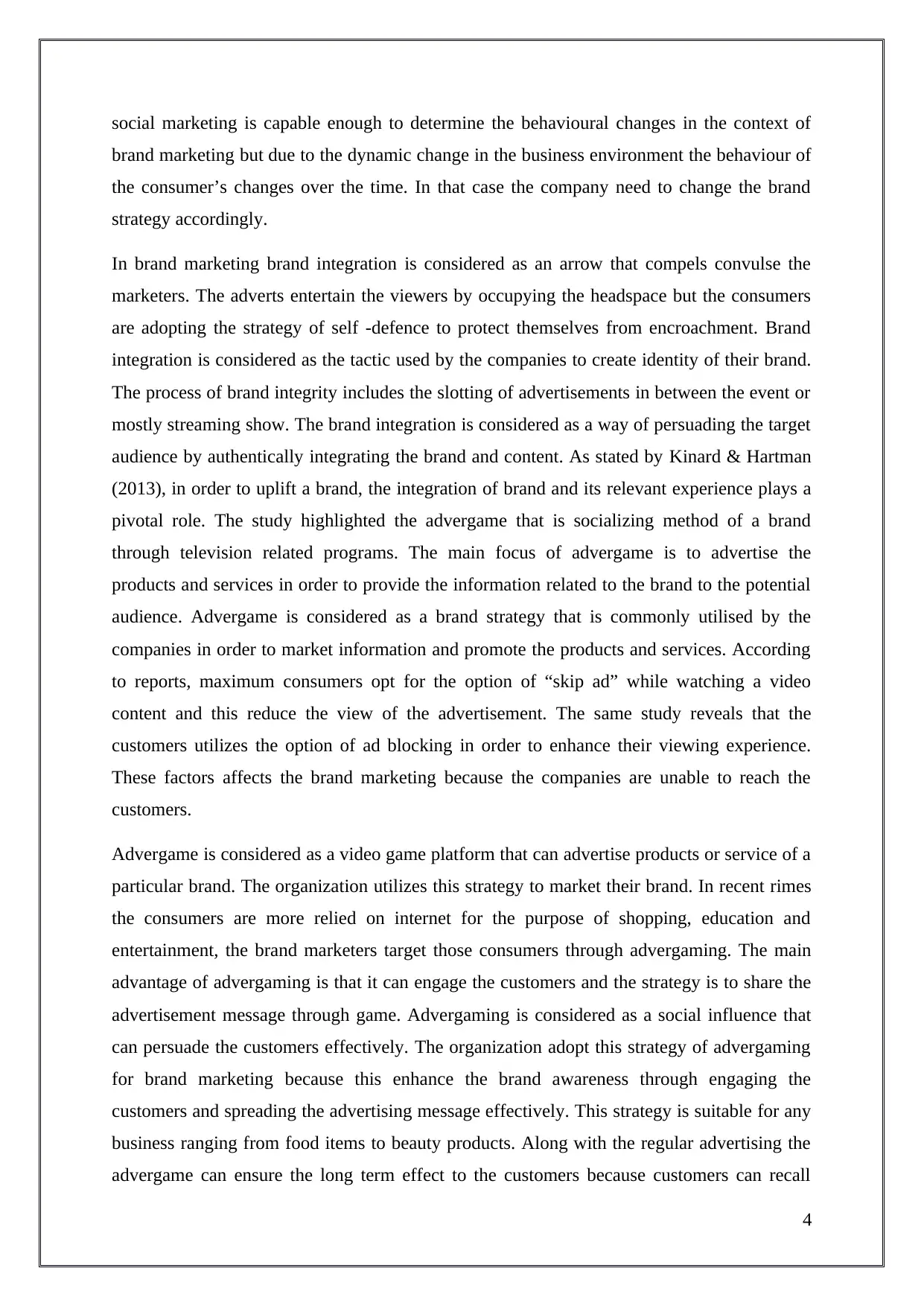
social marketing is capable enough to determine the behavioural changes in the context of
brand marketing but due to the dynamic change in the business environment the behaviour of
the consumer’s changes over the time. In that case the company need to change the brand
strategy accordingly.
In brand marketing brand integration is considered as an arrow that compels convulse the
marketers. The adverts entertain the viewers by occupying the headspace but the consumers
are adopting the strategy of self -defence to protect themselves from encroachment. Brand
integration is considered as the tactic used by the companies to create identity of their brand.
The process of brand integrity includes the slotting of advertisements in between the event or
mostly streaming show. The brand integration is considered as a way of persuading the target
audience by authentically integrating the brand and content. As stated by Kinard & Hartman
(2013), in order to uplift a brand, the integration of brand and its relevant experience plays a
pivotal role. The study highlighted the advergame that is socializing method of a brand
through television related programs. The main focus of advergame is to advertise the
products and services in order to provide the information related to the brand to the potential
audience. Advergame is considered as a brand strategy that is commonly utilised by the
companies in order to market information and promote the products and services. According
to reports, maximum consumers opt for the option of “skip ad” while watching a video
content and this reduce the view of the advertisement. The same study reveals that the
customers utilizes the option of ad blocking in order to enhance their viewing experience.
These factors affects the brand marketing because the companies are unable to reach the
customers.
Advergame is considered as a video game platform that can advertise products or service of a
particular brand. The organization utilizes this strategy to market their brand. In recent rimes
the consumers are more relied on internet for the purpose of shopping, education and
entertainment, the brand marketers target those consumers through advergaming. The main
advantage of advergaming is that it can engage the customers and the strategy is to share the
advertisement message through game. Advergaming is considered as a social influence that
can persuade the customers effectively. The organization adopt this strategy of advergaming
for brand marketing because this enhance the brand awareness through engaging the
customers and spreading the advertising message effectively. This strategy is suitable for any
business ranging from food items to beauty products. Along with the regular advertising the
advergame can ensure the long term effect to the customers because customers can recall
4
brand marketing but due to the dynamic change in the business environment the behaviour of
the consumer’s changes over the time. In that case the company need to change the brand
strategy accordingly.
In brand marketing brand integration is considered as an arrow that compels convulse the
marketers. The adverts entertain the viewers by occupying the headspace but the consumers
are adopting the strategy of self -defence to protect themselves from encroachment. Brand
integration is considered as the tactic used by the companies to create identity of their brand.
The process of brand integrity includes the slotting of advertisements in between the event or
mostly streaming show. The brand integration is considered as a way of persuading the target
audience by authentically integrating the brand and content. As stated by Kinard & Hartman
(2013), in order to uplift a brand, the integration of brand and its relevant experience plays a
pivotal role. The study highlighted the advergame that is socializing method of a brand
through television related programs. The main focus of advergame is to advertise the
products and services in order to provide the information related to the brand to the potential
audience. Advergame is considered as a brand strategy that is commonly utilised by the
companies in order to market information and promote the products and services. According
to reports, maximum consumers opt for the option of “skip ad” while watching a video
content and this reduce the view of the advertisement. The same study reveals that the
customers utilizes the option of ad blocking in order to enhance their viewing experience.
These factors affects the brand marketing because the companies are unable to reach the
customers.
Advergame is considered as a video game platform that can advertise products or service of a
particular brand. The organization utilizes this strategy to market their brand. In recent rimes
the consumers are more relied on internet for the purpose of shopping, education and
entertainment, the brand marketers target those consumers through advergaming. The main
advantage of advergaming is that it can engage the customers and the strategy is to share the
advertisement message through game. Advergaming is considered as a social influence that
can persuade the customers effectively. The organization adopt this strategy of advergaming
for brand marketing because this enhance the brand awareness through engaging the
customers and spreading the advertising message effectively. This strategy is suitable for any
business ranging from food items to beauty products. Along with the regular advertising the
advergame can ensure the long term effect to the customers because customers can recall
4
Paraphrase This Document
Need a fresh take? Get an instant paraphrase of this document with our AI Paraphraser
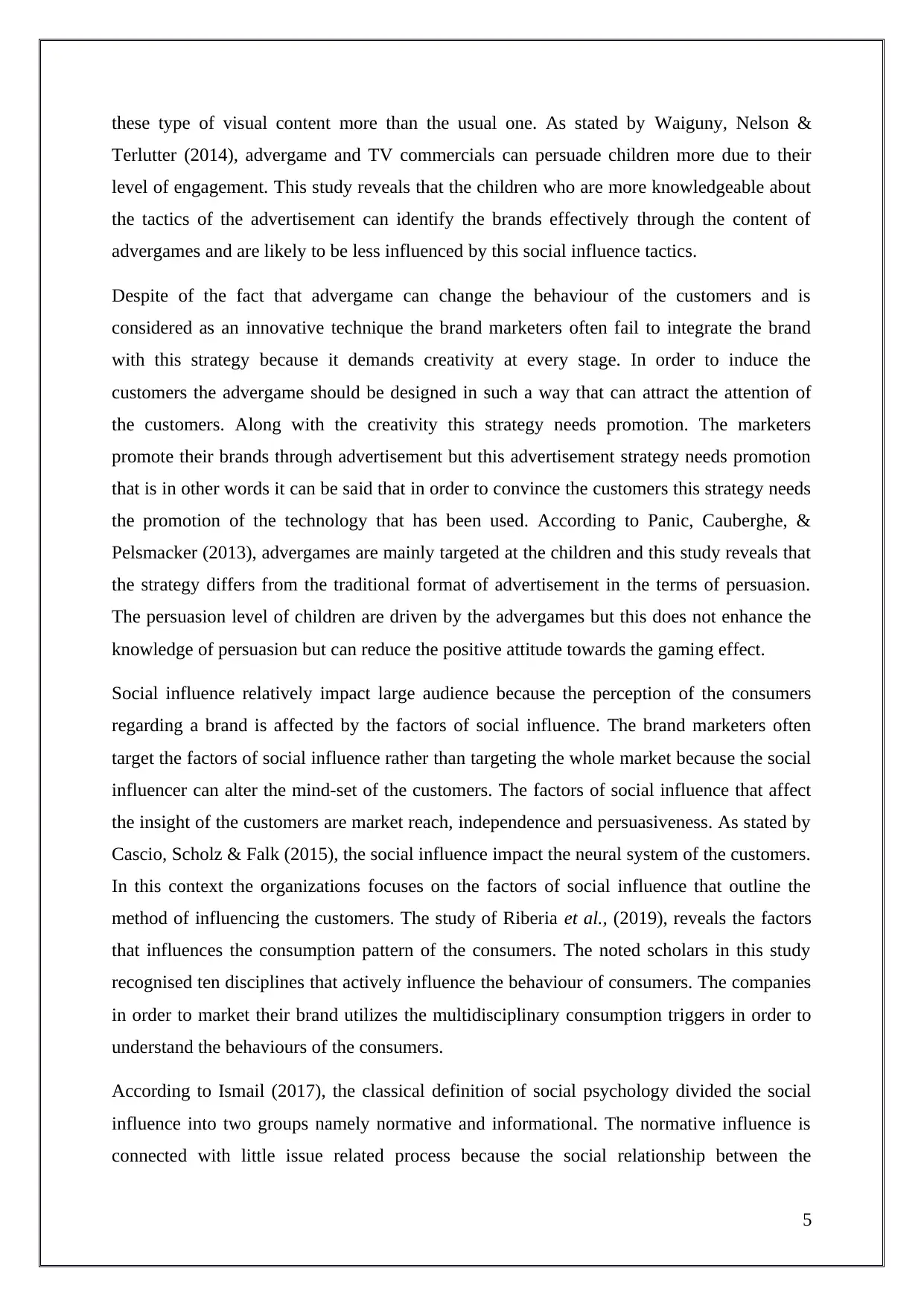
these type of visual content more than the usual one. As stated by Waiguny, Nelson &
Terlutter (2014), advergame and TV commercials can persuade children more due to their
level of engagement. This study reveals that the children who are more knowledgeable about
the tactics of the advertisement can identify the brands effectively through the content of
advergames and are likely to be less influenced by this social influence tactics.
Despite of the fact that advergame can change the behaviour of the customers and is
considered as an innovative technique the brand marketers often fail to integrate the brand
with this strategy because it demands creativity at every stage. In order to induce the
customers the advergame should be designed in such a way that can attract the attention of
the customers. Along with the creativity this strategy needs promotion. The marketers
promote their brands through advertisement but this advertisement strategy needs promotion
that is in other words it can be said that in order to convince the customers this strategy needs
the promotion of the technology that has been used. According to Panic, Cauberghe, &
Pelsmacker (2013), advergames are mainly targeted at the children and this study reveals that
the strategy differs from the traditional format of advertisement in the terms of persuasion.
The persuasion level of children are driven by the advergames but this does not enhance the
knowledge of persuasion but can reduce the positive attitude towards the gaming effect.
Social influence relatively impact large audience because the perception of the consumers
regarding a brand is affected by the factors of social influence. The brand marketers often
target the factors of social influence rather than targeting the whole market because the social
influencer can alter the mind-set of the customers. The factors of social influence that affect
the insight of the customers are market reach, independence and persuasiveness. As stated by
Cascio, Scholz & Falk (2015), the social influence impact the neural system of the customers.
In this context the organizations focuses on the factors of social influence that outline the
method of influencing the customers. The study of Riberia et al., (2019), reveals the factors
that influences the consumption pattern of the consumers. The noted scholars in this study
recognised ten disciplines that actively influence the behaviour of consumers. The companies
in order to market their brand utilizes the multidisciplinary consumption triggers in order to
understand the behaviours of the consumers.
According to Ismail (2017), the classical definition of social psychology divided the social
influence into two groups namely normative and informational. The normative influence is
connected with little issue related process because the social relationship between the
5
Terlutter (2014), advergame and TV commercials can persuade children more due to their
level of engagement. This study reveals that the children who are more knowledgeable about
the tactics of the advertisement can identify the brands effectively through the content of
advergames and are likely to be less influenced by this social influence tactics.
Despite of the fact that advergame can change the behaviour of the customers and is
considered as an innovative technique the brand marketers often fail to integrate the brand
with this strategy because it demands creativity at every stage. In order to induce the
customers the advergame should be designed in such a way that can attract the attention of
the customers. Along with the creativity this strategy needs promotion. The marketers
promote their brands through advertisement but this advertisement strategy needs promotion
that is in other words it can be said that in order to convince the customers this strategy needs
the promotion of the technology that has been used. According to Panic, Cauberghe, &
Pelsmacker (2013), advergames are mainly targeted at the children and this study reveals that
the strategy differs from the traditional format of advertisement in the terms of persuasion.
The persuasion level of children are driven by the advergames but this does not enhance the
knowledge of persuasion but can reduce the positive attitude towards the gaming effect.
Social influence relatively impact large audience because the perception of the consumers
regarding a brand is affected by the factors of social influence. The brand marketers often
target the factors of social influence rather than targeting the whole market because the social
influencer can alter the mind-set of the customers. The factors of social influence that affect
the insight of the customers are market reach, independence and persuasiveness. As stated by
Cascio, Scholz & Falk (2015), the social influence impact the neural system of the customers.
In this context the organizations focuses on the factors of social influence that outline the
method of influencing the customers. The study of Riberia et al., (2019), reveals the factors
that influences the consumption pattern of the consumers. The noted scholars in this study
recognised ten disciplines that actively influence the behaviour of consumers. The companies
in order to market their brand utilizes the multidisciplinary consumption triggers in order to
understand the behaviours of the consumers.
According to Ismail (2017), the classical definition of social psychology divided the social
influence into two groups namely normative and informational. The normative influence is
connected with little issue related process because the social relationship between the
5
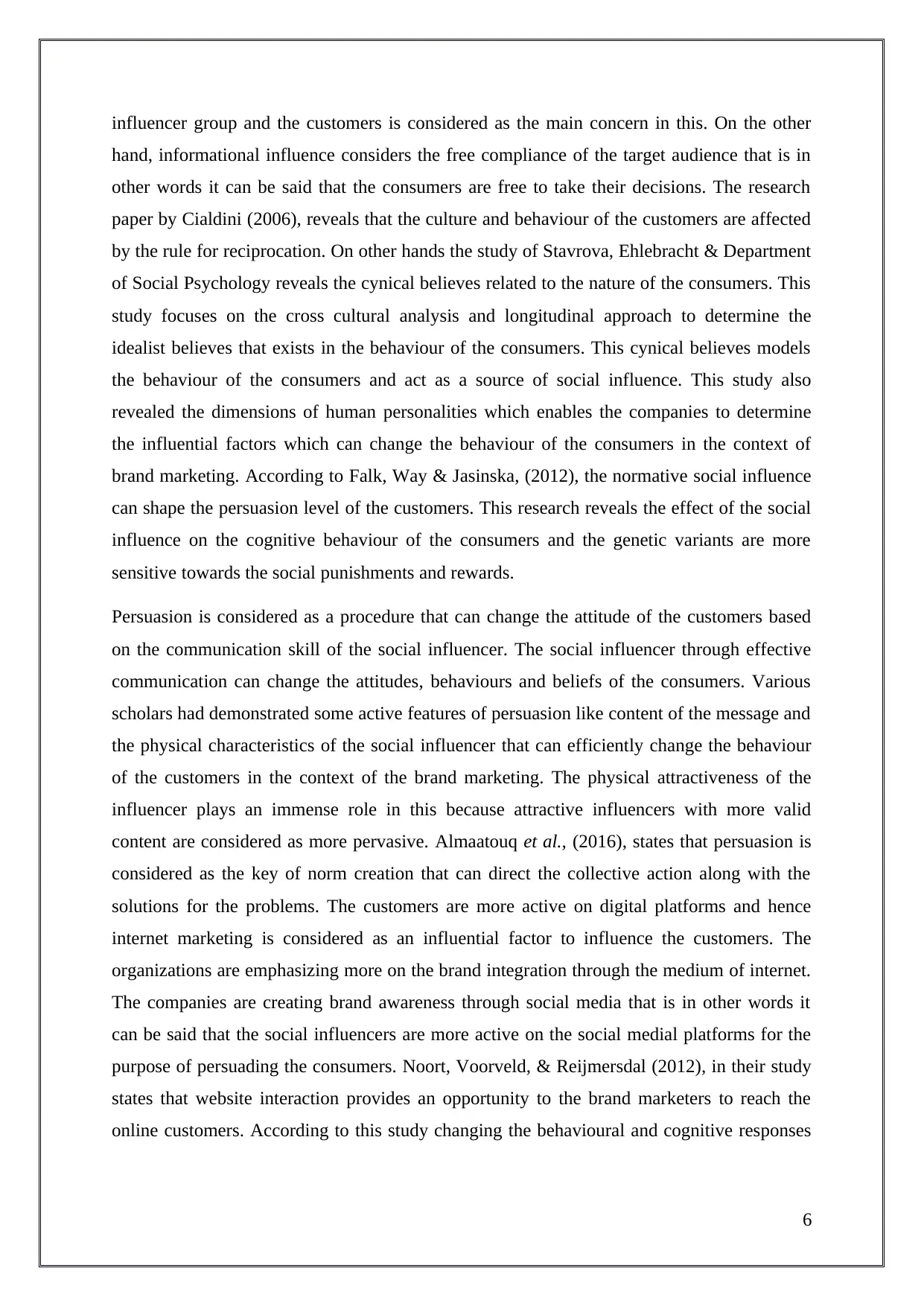
influencer group and the customers is considered as the main concern in this. On the other
hand, informational influence considers the free compliance of the target audience that is in
other words it can be said that the consumers are free to take their decisions. The research
paper by Cialdini (2006), reveals that the culture and behaviour of the customers are affected
by the rule for reciprocation. On other hands the study of Stavrova, Ehlebracht & Department
of Social Psychology reveals the cynical believes related to the nature of the consumers. This
study focuses on the cross cultural analysis and longitudinal approach to determine the
idealist believes that exists in the behaviour of the consumers. This cynical believes models
the behaviour of the consumers and act as a source of social influence. This study also
revealed the dimensions of human personalities which enables the companies to determine
the influential factors which can change the behaviour of the consumers in the context of
brand marketing. According to Falk, Way & Jasinska, (2012), the normative social influence
can shape the persuasion level of the customers. This research reveals the effect of the social
influence on the cognitive behaviour of the consumers and the genetic variants are more
sensitive towards the social punishments and rewards.
Persuasion is considered as a procedure that can change the attitude of the customers based
on the communication skill of the social influencer. The social influencer through effective
communication can change the attitudes, behaviours and beliefs of the consumers. Various
scholars had demonstrated some active features of persuasion like content of the message and
the physical characteristics of the social influencer that can efficiently change the behaviour
of the customers in the context of the brand marketing. The physical attractiveness of the
influencer plays an immense role in this because attractive influencers with more valid
content are considered as more pervasive. Almaatouq et al., (2016), states that persuasion is
considered as the key of norm creation that can direct the collective action along with the
solutions for the problems. The customers are more active on digital platforms and hence
internet marketing is considered as an influential factor to influence the customers. The
organizations are emphasizing more on the brand integration through the medium of internet.
The companies are creating brand awareness through social media that is in other words it
can be said that the social influencers are more active on the social medial platforms for the
purpose of persuading the consumers. Noort, Voorveld, & Reijmersdal (2012), in their study
states that website interaction provides an opportunity to the brand marketers to reach the
online customers. According to this study changing the behavioural and cognitive responses
6
hand, informational influence considers the free compliance of the target audience that is in
other words it can be said that the consumers are free to take their decisions. The research
paper by Cialdini (2006), reveals that the culture and behaviour of the customers are affected
by the rule for reciprocation. On other hands the study of Stavrova, Ehlebracht & Department
of Social Psychology reveals the cynical believes related to the nature of the consumers. This
study focuses on the cross cultural analysis and longitudinal approach to determine the
idealist believes that exists in the behaviour of the consumers. This cynical believes models
the behaviour of the consumers and act as a source of social influence. This study also
revealed the dimensions of human personalities which enables the companies to determine
the influential factors which can change the behaviour of the consumers in the context of
brand marketing. According to Falk, Way & Jasinska, (2012), the normative social influence
can shape the persuasion level of the customers. This research reveals the effect of the social
influence on the cognitive behaviour of the consumers and the genetic variants are more
sensitive towards the social punishments and rewards.
Persuasion is considered as a procedure that can change the attitude of the customers based
on the communication skill of the social influencer. The social influencer through effective
communication can change the attitudes, behaviours and beliefs of the consumers. Various
scholars had demonstrated some active features of persuasion like content of the message and
the physical characteristics of the social influencer that can efficiently change the behaviour
of the customers in the context of the brand marketing. The physical attractiveness of the
influencer plays an immense role in this because attractive influencers with more valid
content are considered as more pervasive. Almaatouq et al., (2016), states that persuasion is
considered as the key of norm creation that can direct the collective action along with the
solutions for the problems. The customers are more active on digital platforms and hence
internet marketing is considered as an influential factor to influence the customers. The
organizations are emphasizing more on the brand integration through the medium of internet.
The companies are creating brand awareness through social media that is in other words it
can be said that the social influencers are more active on the social medial platforms for the
purpose of persuading the consumers. Noort, Voorveld, & Reijmersdal (2012), in their study
states that website interaction provides an opportunity to the brand marketers to reach the
online customers. According to this study changing the behavioural and cognitive responses
6
⊘ This is a preview!⊘
Do you want full access?
Subscribe today to unlock all pages.

Trusted by 1+ million students worldwide
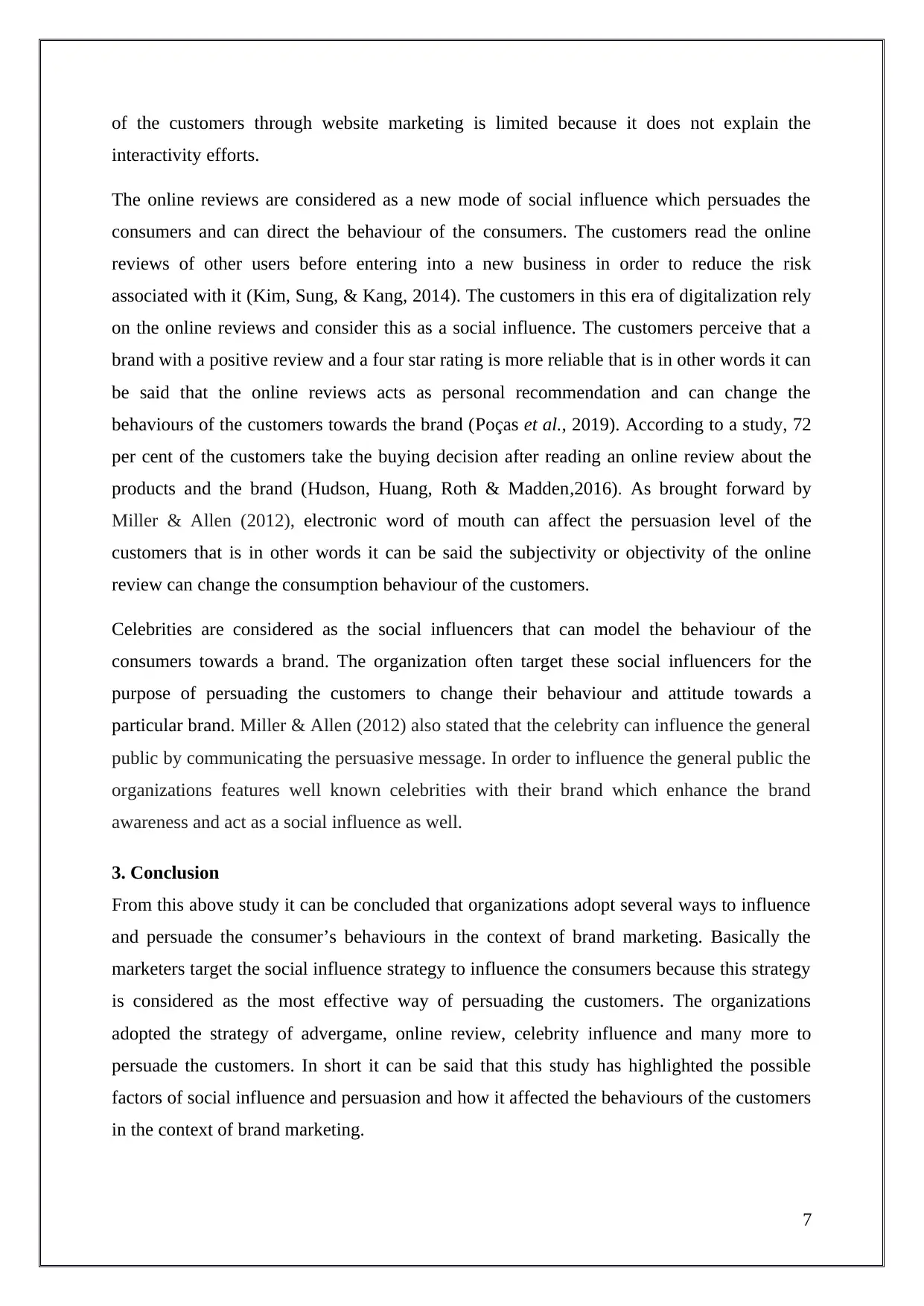
of the customers through website marketing is limited because it does not explain the
interactivity efforts.
The online reviews are considered as a new mode of social influence which persuades the
consumers and can direct the behaviour of the consumers. The customers read the online
reviews of other users before entering into a new business in order to reduce the risk
associated with it (Kim, Sung, & Kang, 2014). The customers in this era of digitalization rely
on the online reviews and consider this as a social influence. The customers perceive that a
brand with a positive review and a four star rating is more reliable that is in other words it can
be said that the online reviews acts as personal recommendation and can change the
behaviours of the customers towards the brand (Poças et al., 2019). According to a study, 72
per cent of the customers take the buying decision after reading an online review about the
products and the brand (Hudson, Huang, Roth & Madden,2016). As brought forward by
Miller & Allen (2012), electronic word of mouth can affect the persuasion level of the
customers that is in other words it can be said the subjectivity or objectivity of the online
review can change the consumption behaviour of the customers.
Celebrities are considered as the social influencers that can model the behaviour of the
consumers towards a brand. The organization often target these social influencers for the
purpose of persuading the customers to change their behaviour and attitude towards a
particular brand. Miller & Allen (2012) also stated that the celebrity can influence the general
public by communicating the persuasive message. In order to influence the general public the
organizations features well known celebrities with their brand which enhance the brand
awareness and act as a social influence as well.
3. Conclusion
From this above study it can be concluded that organizations adopt several ways to influence
and persuade the consumer’s behaviours in the context of brand marketing. Basically the
marketers target the social influence strategy to influence the consumers because this strategy
is considered as the most effective way of persuading the customers. The organizations
adopted the strategy of advergame, online review, celebrity influence and many more to
persuade the customers. In short it can be said that this study has highlighted the possible
factors of social influence and persuasion and how it affected the behaviours of the customers
in the context of brand marketing.
7
interactivity efforts.
The online reviews are considered as a new mode of social influence which persuades the
consumers and can direct the behaviour of the consumers. The customers read the online
reviews of other users before entering into a new business in order to reduce the risk
associated with it (Kim, Sung, & Kang, 2014). The customers in this era of digitalization rely
on the online reviews and consider this as a social influence. The customers perceive that a
brand with a positive review and a four star rating is more reliable that is in other words it can
be said that the online reviews acts as personal recommendation and can change the
behaviours of the customers towards the brand (Poças et al., 2019). According to a study, 72
per cent of the customers take the buying decision after reading an online review about the
products and the brand (Hudson, Huang, Roth & Madden,2016). As brought forward by
Miller & Allen (2012), electronic word of mouth can affect the persuasion level of the
customers that is in other words it can be said the subjectivity or objectivity of the online
review can change the consumption behaviour of the customers.
Celebrities are considered as the social influencers that can model the behaviour of the
consumers towards a brand. The organization often target these social influencers for the
purpose of persuading the customers to change their behaviour and attitude towards a
particular brand. Miller & Allen (2012) also stated that the celebrity can influence the general
public by communicating the persuasive message. In order to influence the general public the
organizations features well known celebrities with their brand which enhance the brand
awareness and act as a social influence as well.
3. Conclusion
From this above study it can be concluded that organizations adopt several ways to influence
and persuade the consumer’s behaviours in the context of brand marketing. Basically the
marketers target the social influence strategy to influence the consumers because this strategy
is considered as the most effective way of persuading the customers. The organizations
adopted the strategy of advergame, online review, celebrity influence and many more to
persuade the customers. In short it can be said that this study has highlighted the possible
factors of social influence and persuasion and how it affected the behaviours of the customers
in the context of brand marketing.
7
Paraphrase This Document
Need a fresh take? Get an instant paraphrase of this document with our AI Paraphraser
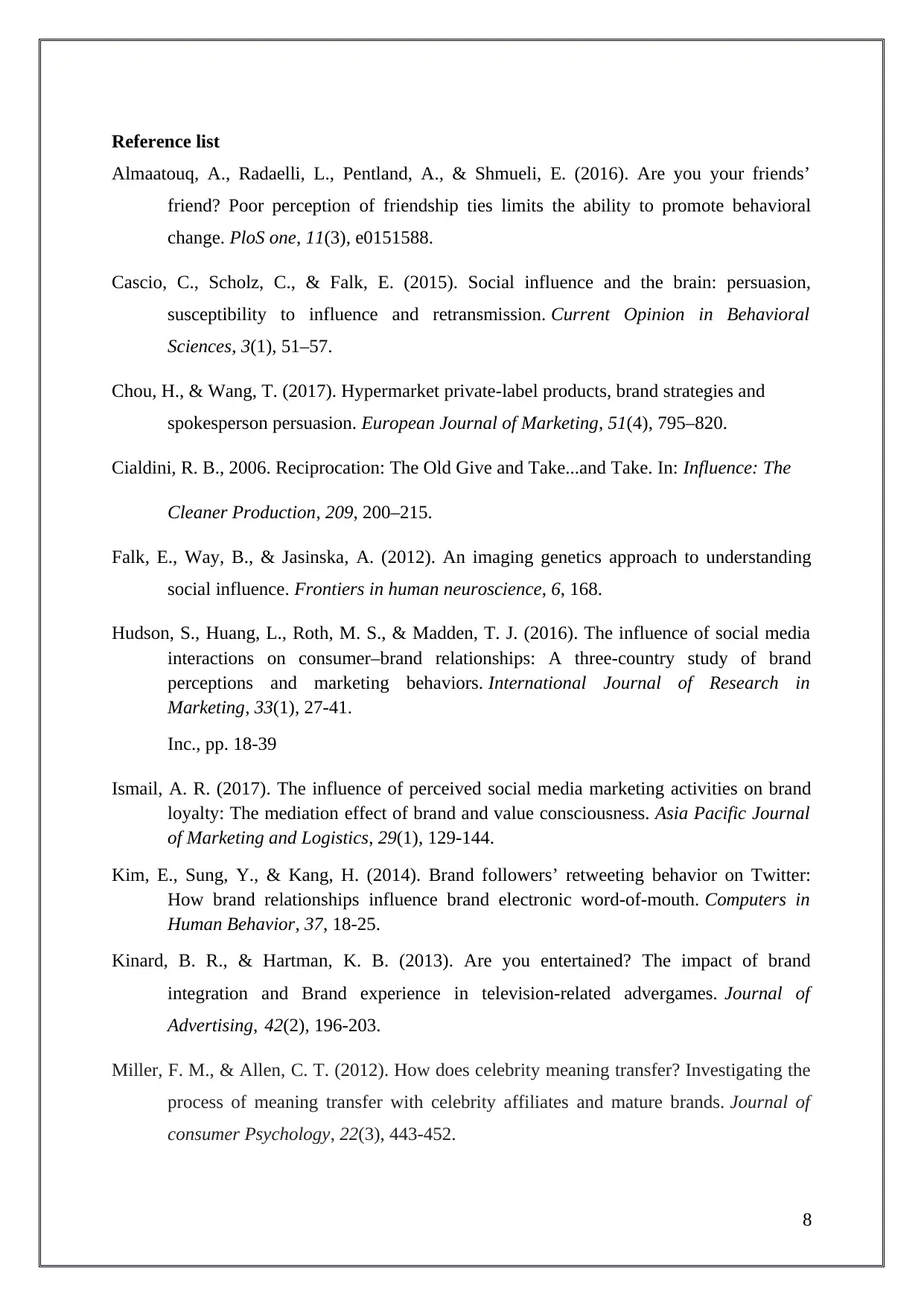
Reference list
Almaatouq, A., Radaelli, L., Pentland, A., & Shmueli, E. (2016). Are you your friends’
friend? Poor perception of friendship ties limits the ability to promote behavioral
change. PloS one, 11(3), e0151588.
Cascio, C., Scholz, C., & Falk, E. (2015). Social influence and the brain: persuasion,
susceptibility to influence and retransmission. Current Opinion in Behavioral
Sciences, 3(1), 51–57.
Chou, H., & Wang, T. (2017). Hypermarket private-label products, brand strategies and
spokesperson persuasion. European Journal of Marketing, 51(4), 795–820.
Cialdini, R. B., 2006. Reciprocation: The Old Give and Take...and Take. In: Influence: The
Cleaner Production, 209, 200–215.
Falk, E., Way, B., & Jasinska, A. (2012). An imaging genetics approach to understanding
social influence. Frontiers in human neuroscience, 6, 168.
Hudson, S., Huang, L., Roth, M. S., & Madden, T. J. (2016). The influence of social media
interactions on consumer–brand relationships: A three-country study of brand
perceptions and marketing behaviors. International Journal of Research in
Marketing, 33(1), 27-41.
Inc., pp. 18-39
Ismail, A. R. (2017). The influence of perceived social media marketing activities on brand
loyalty: The mediation effect of brand and value consciousness. Asia Pacific Journal
of Marketing and Logistics, 29(1), 129-144.
Kim, E., Sung, Y., & Kang, H. (2014). Brand followers’ retweeting behavior on Twitter:
How brand relationships influence brand electronic word-of-mouth. Computers in
Human Behavior, 37, 18-25.
Kinard, B. R., & Hartman, K. B. (2013). Are you entertained? The impact of brand
integration and Brand experience in television-related advergames. Journal of
Advertising, 42(2), 196-203.
Miller, F. M., & Allen, C. T. (2012). How does celebrity meaning transfer? Investigating the
process of meaning transfer with celebrity affiliates and mature brands. Journal of
consumer Psychology, 22(3), 443-452.
8
Almaatouq, A., Radaelli, L., Pentland, A., & Shmueli, E. (2016). Are you your friends’
friend? Poor perception of friendship ties limits the ability to promote behavioral
change. PloS one, 11(3), e0151588.
Cascio, C., Scholz, C., & Falk, E. (2015). Social influence and the brain: persuasion,
susceptibility to influence and retransmission. Current Opinion in Behavioral
Sciences, 3(1), 51–57.
Chou, H., & Wang, T. (2017). Hypermarket private-label products, brand strategies and
spokesperson persuasion. European Journal of Marketing, 51(4), 795–820.
Cialdini, R. B., 2006. Reciprocation: The Old Give and Take...and Take. In: Influence: The
Cleaner Production, 209, 200–215.
Falk, E., Way, B., & Jasinska, A. (2012). An imaging genetics approach to understanding
social influence. Frontiers in human neuroscience, 6, 168.
Hudson, S., Huang, L., Roth, M. S., & Madden, T. J. (2016). The influence of social media
interactions on consumer–brand relationships: A three-country study of brand
perceptions and marketing behaviors. International Journal of Research in
Marketing, 33(1), 27-41.
Inc., pp. 18-39
Ismail, A. R. (2017). The influence of perceived social media marketing activities on brand
loyalty: The mediation effect of brand and value consciousness. Asia Pacific Journal
of Marketing and Logistics, 29(1), 129-144.
Kim, E., Sung, Y., & Kang, H. (2014). Brand followers’ retweeting behavior on Twitter:
How brand relationships influence brand electronic word-of-mouth. Computers in
Human Behavior, 37, 18-25.
Kinard, B. R., & Hartman, K. B. (2013). Are you entertained? The impact of brand
integration and Brand experience in television-related advergames. Journal of
Advertising, 42(2), 196-203.
Miller, F. M., & Allen, C. T. (2012). How does celebrity meaning transfer? Investigating the
process of meaning transfer with celebrity affiliates and mature brands. Journal of
consumer Psychology, 22(3), 443-452.
8
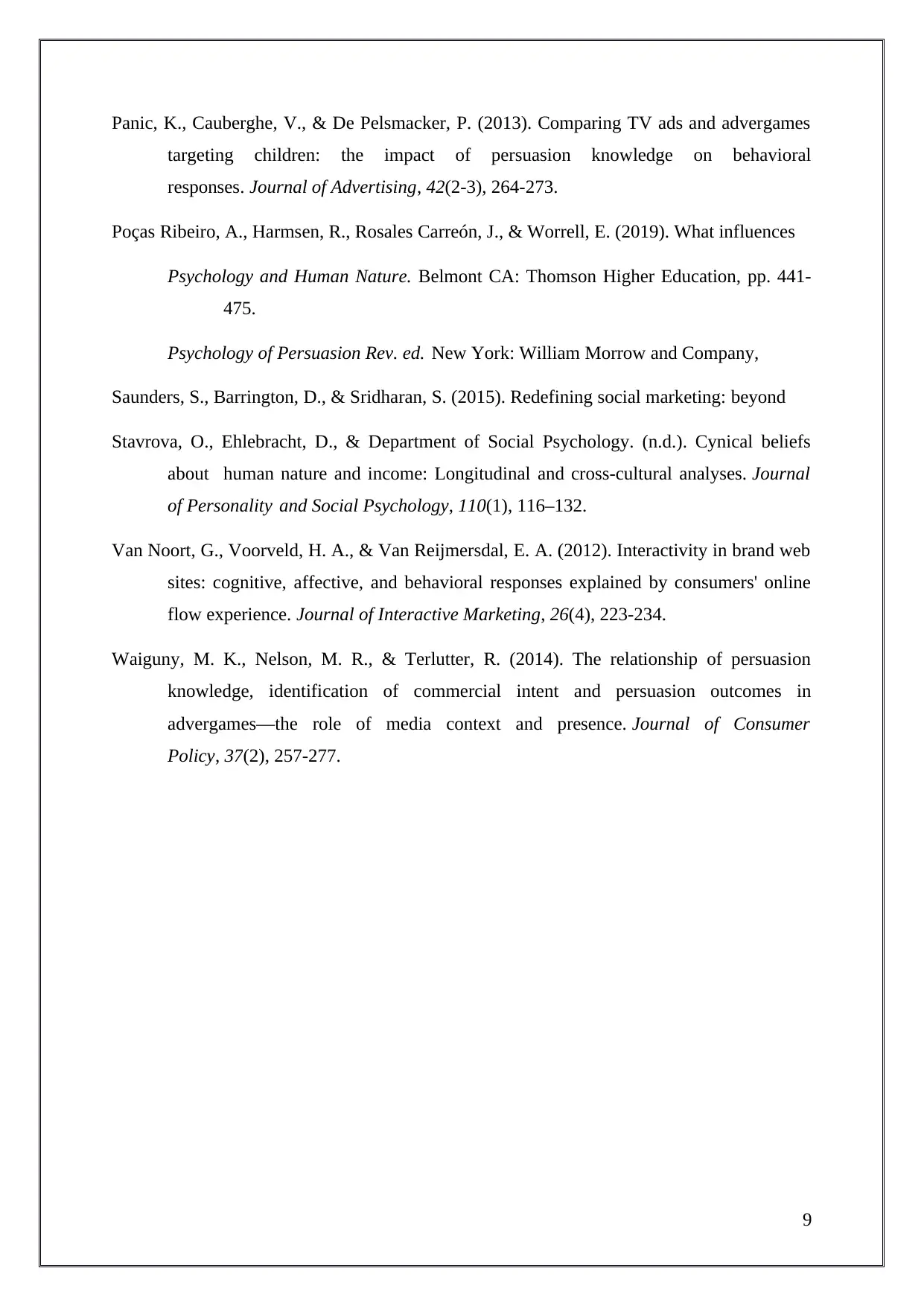
Panic, K., Cauberghe, V., & De Pelsmacker, P. (2013). Comparing TV ads and advergames
targeting children: the impact of persuasion knowledge on behavioral
responses. Journal of Advertising, 42(2-3), 264-273.
Poças Ribeiro, A., Harmsen, R., Rosales Carreón, J., & Worrell, E. (2019). What influences
Psychology and Human Nature. Belmont CA: Thomson Higher Education, pp. 441-
475.
Psychology of Persuasion Rev. ed. New York: William Morrow and Company,
Saunders, S., Barrington, D., & Sridharan, S. (2015). Redefining social marketing: beyond
Stavrova, O., Ehlebracht, D., & Department of Social Psychology. (n.d.). Cynical beliefs
about human nature and income: Longitudinal and cross-cultural analyses. Journal
of Personality and Social Psychology, 110(1), 116–132.
Van Noort, G., Voorveld, H. A., & Van Reijmersdal, E. A. (2012). Interactivity in brand web
sites: cognitive, affective, and behavioral responses explained by consumers' online
flow experience. Journal of Interactive Marketing, 26(4), 223-234.
Waiguny, M. K., Nelson, M. R., & Terlutter, R. (2014). The relationship of persuasion
knowledge, identification of commercial intent and persuasion outcomes in
advergames—the role of media context and presence. Journal of Consumer
Policy, 37(2), 257-277.
9
targeting children: the impact of persuasion knowledge on behavioral
responses. Journal of Advertising, 42(2-3), 264-273.
Poças Ribeiro, A., Harmsen, R., Rosales Carreón, J., & Worrell, E. (2019). What influences
Psychology and Human Nature. Belmont CA: Thomson Higher Education, pp. 441-
475.
Psychology of Persuasion Rev. ed. New York: William Morrow and Company,
Saunders, S., Barrington, D., & Sridharan, S. (2015). Redefining social marketing: beyond
Stavrova, O., Ehlebracht, D., & Department of Social Psychology. (n.d.). Cynical beliefs
about human nature and income: Longitudinal and cross-cultural analyses. Journal
of Personality and Social Psychology, 110(1), 116–132.
Van Noort, G., Voorveld, H. A., & Van Reijmersdal, E. A. (2012). Interactivity in brand web
sites: cognitive, affective, and behavioral responses explained by consumers' online
flow experience. Journal of Interactive Marketing, 26(4), 223-234.
Waiguny, M. K., Nelson, M. R., & Terlutter, R. (2014). The relationship of persuasion
knowledge, identification of commercial intent and persuasion outcomes in
advergames—the role of media context and presence. Journal of Consumer
Policy, 37(2), 257-277.
9
⊘ This is a preview!⊘
Do you want full access?
Subscribe today to unlock all pages.

Trusted by 1+ million students worldwide
1 out of 9
Related Documents
Your All-in-One AI-Powered Toolkit for Academic Success.
+13062052269
info@desklib.com
Available 24*7 on WhatsApp / Email
![[object Object]](/_next/static/media/star-bottom.7253800d.svg)
Unlock your academic potential
Copyright © 2020–2025 A2Z Services. All Rights Reserved. Developed and managed by ZUCOL.



